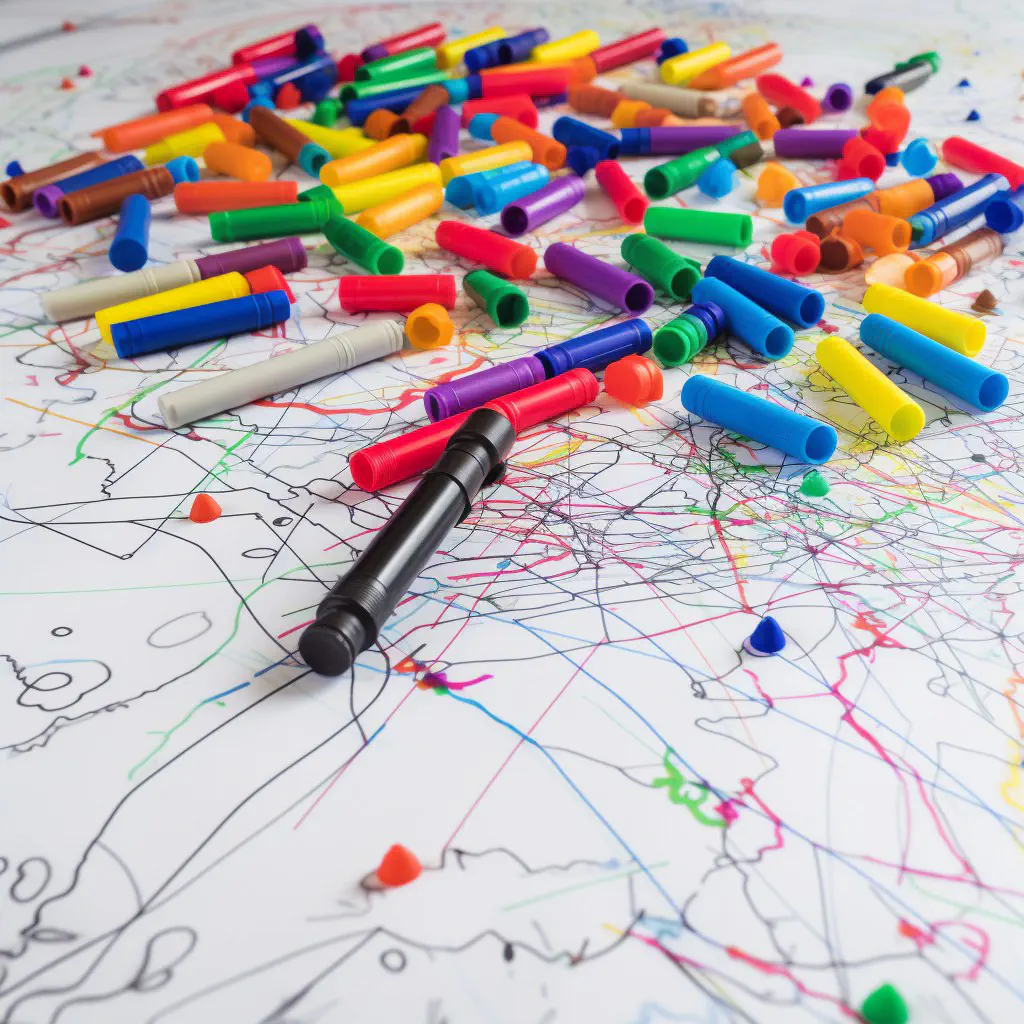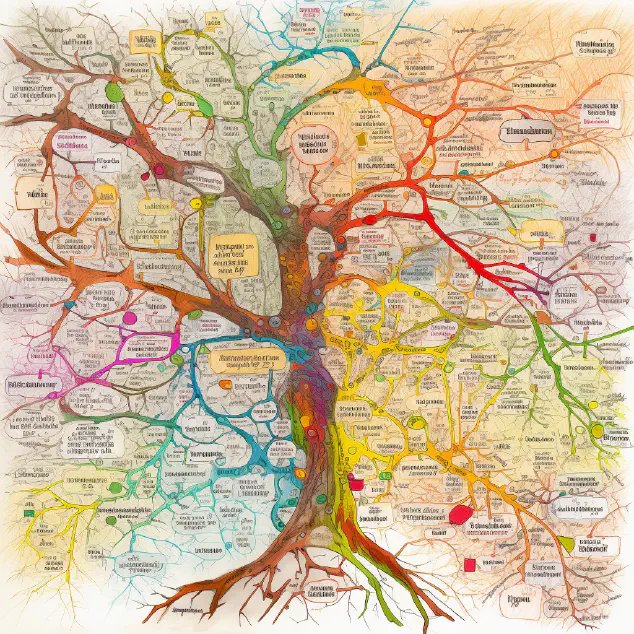
Introduction
Are you looking for a way to unlock your creativity? Look no further than mind mapping! Mind mapping is a powerful tool for organizing and exploring your thoughts and ideas, and can be used to stimulate your creativity in countless ways.
At its simplest, a mind map is a visual diagram that captures your ideas and information in a non-linear format. Unlike traditional notes, which are often organized in a linear, hierarchical way, mind maps allow you to see connections and relationships between ideas in a more intuitive and creative way.
But mind mapping isn’t just a tool for organizing information. It’s also a powerful technique for stimulating your imagination and unlocking your creativity. By engaging the visual part of your brain, mind mapping can help you generate new ideas, make new connections, and come up with fresh insights that you might not have discovered otherwise.
In this guide, we’ll take a closer look at the power of mind mapping for creativity, and show you how to use this technique to stimulate your own imagination and unleash your full creative potential. Whether you’re an artist, a writer, a designer, or anyone else with a creative spark, we think you’ll find something valuable in this guide. So let’s get started!
Why Mind Mapping Works
One of the key reasons why mind mapping is such a powerful tool is that it takes advantage of the brain’s natural learning process. When we learn and remember information, our brains create connections between pieces of information. Mind maps help to visualize and reinforce these connections, making it easier for us to learn and recall information.
Additionally, mind mapping is a highly visual technique. Research has shown that the brain processes visual information much faster than textual information, making mind maps an effective tool for organizing and processing complex ideas. By presenting information in a visual format, mind maps help us to better understand and retain information.
Compared to traditional note-taking methods, mind mapping is a more flexible and dynamic approach. Unlike linear note-taking, which can be limiting, mind maps allow us to connect and organize information in any way that makes sense to us. This can help us to identify new connections and insights that we might otherwise have missed.
Ultimately, the power of mind mapping lies in its ability to help us think more creatively. By connecting information in new and innovative ways, mind maps encourage us to think outside the box and generate new ideas. As such, mind mapping is an excellent tool for anyone looking to boost their creativity and unlock their full potential.
How to Mind Map
Creating a mind map is simple and straightforward. Here are the steps to create your own mind map:
-
Start with a central idea
- Write down the central idea of your mind map in the center of the page. This could be a word, phrase or image that represents your main idea.
-
Add branches
- Draw branches from the central idea to represent subtopics. Label each branch with a keyword that represents each subtopic.
-
Add details
- From each subtopic, draw branches to include more specific details. These details can be words, images, or phrases that describe each subtopic.
-
Use colors and images
- Use different colors to represent different themes or categories, and add images to make the mind map more visually engaging.
Here are some tips to make your mind map more effective:
-
Use single words or short phrases, to keep the mind map simple and easy to read.
-
Use symbols or icons, to represent concepts and ideas, instead of writing entire words or phrases.
-
Connect related ideas with lines or arrows, to create a visual connection between the ideas.
-
Use hierarchy to organise your ideas, by placing your main ideas in the center and subtopics branching off from the main idea.
-
Use different colors or images to represent different categories of information within your mind map.
Remember, there are no rules when it comes to mind mapping. You can make your mind map as simple or as complex as you like, and add as much detail as you need. It’s all about unlocking your creativity and organising your ideas in a way that makes sense to you.
Mind Mapping Techniques for Creativity
Mind mapping is an effective technique that allows you to visualize information and connect ideas in a non-linear way. It is an excellent tool for boosting creativity. Here are some of the ways to use mind maps for creativity:
Using Mind Maps for Brainstorming
Mind maps are ideal for brainstorming. They allow you to generate many ideas and connect them in a way that makes sense. You can use mind maps to brainstorm for any project, whether it’s writing, designing, or problem-solving.
To use mind maps for brainstorming, start by writing the main idea or problem in the center of the map. Next, branch out with related ideas and sub-themes. Keep branching out with more sub-themes until you have exhausted all the ideas. You can then use the mind map to evaluate the ideas and see which ones are worth pursuing.
Visualizing Goals and Aspirations
Mind maps are also great for visualizing goals and aspirations. You can use them to create a visual representation of what you want to achieve and the steps you need to take to get there. Mind maps can help you clarify your goals, prioritize your tasks, and stay motivated.
To visualize your goals and aspirations, start by writing your main goal in the center of the map. Next, branch out with the steps you need to take to achieve that goal. You can also add images and symbols to make the mind map more visually engaging.
Mapping Out a Creative Project
Mind maps are useful tools for mapping out a creative project. You can use them to plan out your project, break it down into smaller tasks, and track your progress. Mind maps can help you stay organized, focused, and on track.
To map out a creative project, start by writing the project’s name in the center of the map. Next, branch out with the different tasks and sub-tasks you need to complete the project. You can also add deadlines, resources, and team members to the mind map.
Combining Mind Maps with Other Creative Tools
Mind maps can be combined with other creative tools to enhance creativity further. For example, you can use mind maps with mood boards, sketches, and collages to create a more holistic approach to your creative projects.
To combine mind maps with other creative tools, start by creating your mind map. Next, use other creative tools to add more depth and inspiration to the mind map. You can also use the mind map to generate more ideas and connect them to the other creative tools you’re using.
In summary, mind maps are powerful tools for boosting creativity. They can be used for brainstorming, visualizing goals, mapping out a project, and combining with other creative tools. By using mind maps, you can unlock your creativity and unleash your fullest potential.
Case Studies and Examples
Real-Life Examples of Successful Mind Mapping for Creativity
- Walt Disney: Disney is known for using mind maps to come up with innovative ideas for his movies and theme parks. He used a mind map to visualize Disneyland, which ultimately led to its creation.
- Tim Ferriss: Ferriss, author of several bestselling books, uses mind mapping to brainstorm and organize his ideas. He even has a template on his website for readers to use.
- Tony Buzan: Buzan is the inventor of mind mapping and has written several books on the topic. He uses mind maps to organize his writing and as a memory tool.
Case Studies of Companies and Individuals who have Unlocked their Creativity Through Mind Mapping
- Nike: The athletic company uses mind maps to brainstorm new product ideas and marketing strategies.
- Google: The search engine giant uses mind maps for project management and to organize ideas for new products and services.
- Pixar: The animation company uses mind maps to plan out storylines and character development for their movies.
Mind Mapping in Action: Mapping Out a Creative Project
Let’s say you’re a writer and you’re working on a novel. You could create a mind map to organize your ideas and plot points. Here’s an example:

In this mind map, the central idea is the novel’s plot and the branches are the individual plot points. You can see how easily this allows you to visualize the story’s structure and make connections between different elements.
Combining Mind Maps with Other Creative Tools
Mind maps can be used in conjunction with other creative tools to further enhance your productivity. Some examples include:
- Pomodoro technique: Use a mind map to plan out your work in 25-minute intervals, using the Pomodoro technique.
- Sketching: Use a mind map as a starting point for sketches and doodles to further flesh out your ideas.
- Storyboarding: Use a mind map to plan out a visual storyboard for a project, such as a video or graphic novel.
Overall, mind mapping is a powerful tool for unlocking your creativity. By visualizing your ideas and making connections between them, you can come up with innovative solutions and products. Don’t be afraid to experiment and find what works best for you!
Conclusion
In conclusion, mind mapping is a powerful tool for unlocking creativity and improving learning. By visually connecting ideas and concepts, we can stimulate the brain’s ability to make new associations and generate original thoughts. Additionally, mind mapping can be used for goal-setting, planning, and organizing complex information.
If you haven’t already tried mind mapping for creativity, we encourage you to give it a try. Start small, with a simple project or idea, and experiment with different techniques to find what works best for you. With practice, you’ll find that mind mapping can help you generate new ideas, solve problems, and unlock the limitless potential of your creative mind.
To learn more about mind mapping and explore additional techniques, be sure to check out the resources listed below:
- Mind Mapping for Dummies
- Mind Mapping Techniques from MindTools
- Free Mind Map Templates from MindMeister.
Remember, the power to unlock your creativity is in your hands. Mind mapping is just one tool to help you get there. Keep exploring, experimenting, and pushing your boundaries to achieve your creative goals. Good luck!


